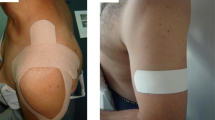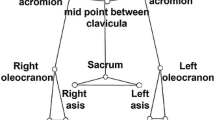Abstract
Purpose
Postoperative exercises may increase load on repaired tendons. Differences in the activity of the rotator cuff muscles were assessed during several different types of passive shoulder and active elbow exercises.
Methods
In 15 healthy subjects, passive forward flexion of the shoulder was performed using a table, pulley and rope, and a cane, and external rotation was performed using a cane and a wall. The active elbow flexion–extension exercise was also performed while holding the upper arm with the contralateral hand. Activation amplitudes of the supraspinatus, infraspinatus and subscapularis muscles were evaluated using electromyography with fine wires.
Results
During passive forward flexion, the supraspinatus and infraspinatus muscles exhibited lower activity when using a table compared with a cane (both P < 0.01) and a pulley and rope (both P < 0.05). Flexion of <90° decreased supraspinatus activation compared with 170° (P = 0.047). During external rotation of the shoulder while using the cane and wall, there was no difference in the activity of any muscles. Electromyographic activity during the active elbow exercise was lower in the supraspinatus while holding the upper arm (P = 0.018).
Conclusion
The table sliding exercise may reduce stress on the rotator cuff during passive forward flexion more than the other exercises do. Decreasing the range of motion to less than 90° in forward flexion activated the supraspinatus less. Moreover, movement of the elbow can be performed holding the upper arm to activate the rotator cuff to a lesser extent.
Level of evidence
Prognostic study, Level II.



Similar content being viewed by others
References
Bigliani LU, Cordasco FA, McIlveen SJ, Musso ES (1992) Operative treatment of failed repairs of the rotator cuff. J Bone Joint Surg Am 74(10):1505–1515
Brewster C, Schwab DR (1993) Rehabilitation of the shoulder following rotator cuff injury or surgery. J Orthop Sports Phys Ther 18(2):422–426
Chester R, Smith TO, Hooper L, Dixon J (2010) The impact of subacromial impingement syndrome on muscle activity patterns of the shoulder complex: a systematic review of electromyographic studies. BMC Musculoskelet Disord 11:45
Cofield RH, Parvizi J, Hoffmeyer PJ, Lanzer WL, Ilstrup DM, Rowland CM (2001) Surgical repair of chronic rotator cuff tears. A prospective long-term study. J Bone Joint Surg Am 83-A(1):71–77
Digiovine NM, Jobe FW, Pink M, Perry J (1992) An electromyographic analysis of the upper extremity in pitching. J Shoulder Elbow Surg 1(1):15–25
Fischer SL, Belbeck AL, Dickerson CR (2010) The influence of providing feedback on force production and within-participant reproducibility during maximal voluntary exertions for the anterior deltoid, middle deltoid, and infraspinatus. J Electromyogr Kinesiol 20(1):68–75
Hermens HJ, Freriks B, Disselhorst-Klug C, Rau G (2000) Development of recommendations for SEMG sensors and sensor placement procedures. J Electromyogr Kinesiol 10(5):361–374
Jarvinen TA, Jozsa L, Kannus P, Jarvinen TL, Hurme T, Kvist M, Pelto-Huikko M, Kalimo H, Jarvinen M (2003) Mechanical loading regulates the expression of tenascin-C in the myotendinous junction and tendon but does not induce de novo synthesis in the skeletal muscle. J Cell Sci 116(Pt 5):857–866
Jobe FW, Moynes DR, Tibone JE, Perry J (1984) An EMG analysis of the shoulder in pitching. A second report. Am J Sports Med 12(3):218–220
Kadaba MP, Cole A, Wootten ME, McCann P, Reid M, Mulford G, April E, Bigliani L (1992) Intramuscular wire electromyography of the subscapularis. J Orthop Res 10(3):394–397
Kannus P, Jozsa L, Natri A, Jarvinen M (1997) Effects of training, immobilization and remobilization on tendons. Scand J Med Sci Sports 7(2):67–71
Kendall FP, McGreary EK, Provance PG, Romani WA (2005) Muscles: testing and function with posture and pain, 5th edn. Williams & Wilkins, Philadelphia
Klintberg IH, Gunnarsson AC, Svantesson U, Styf J, Karlsson J (2009) Early loading in physiotherapy treatment after full-thickness rotator cuff repair: a prospective randomized pilot-study with a two-year follow-up. Clin Rehabil 23(7):622–638
Koo SS, Burkhart SS (2010) Rehabilitation following arthroscopic rotator cuff repair. Clin Sports Med 29(2):203–211
Lee BG, Cho NS, Rhee YG (2012) Effect of two rehabilitation protocols on range of motion and healing rates after arthroscopic rotator cuff repair: aggressive versus limited early passive exercises. Arthroscopy 28(1):34–42
Lee SB, Kim KJ, O’Driscoll SW, Morrey BF, An KN (2000) Dynamic glenohumeral stability provided by the rotator cuff muscles in the mid-range and end-range of motion. A study in cadavera. J Bone Joint Surg Am 82(6):849–857
Long JL, Ruberte Thiele RA, Skendzel JG, Jeon J, Hughes RE, Miller BS, Carpenter JE (2010) Activation of the shoulder musculature during pendulum exercises and light activities. J Orthop Sports Phys Ther 40(4):230–237
Madeleine P, Bajaj P, Sogaard K, Arendt-Nielsen L (2001) Mechanomyography and electromyography force relationships during concentric, isometric and eccentric contractions. J Electromyogr Kinesiol 11(2):113–121
McCann PD, Wootten ME, Kadaba MP, Bigliani LU (1993) A kinematic and electromyographic study of shoulder rehabilitation exercises. Clin Orthop Relat Res 288:179–188
Millett PJ, Wilcox RB 3rd, O’Holleran JD, Warner JJ (2006) Rehabilitation of the rotator cuff: an evaluation-based approach. J Am Acad Orthop Surg 14(11):599–609
Murphy CA, McDermott WJ, Petersen RK, Johnson SE, Baxter SA (2012) Electromyographic analysis of the rotator cuff in postoperative shoulder patients during passive rehabilitation exercises. J Shoulder Elbow Surg 22(1):102–107
Smith J, Dahm DL, Kotajarvi BR, Boon AJ, Laskowski ER, Jacofsky DJ, Kaufman KR (2007) Electromyographic activity in the immobilized shoulder girdle musculature during ipsilateral kinetic chain exercises. Arch Phys Med Rehabil 88(11):1377–1383
Werner CM, Ossendorf C, Meyer DC, Blumenthal S, Gerber C (2010) Subacromial pressures vary with simulated sleep positions. J Shoulder Elbow Surg 19(7):989–993
Wickham J, Pizzari T, Stansfeld K, Burnside A, Watson L (2010) Quantifying ‘normal’ shoulder muscle activity during abduction. J Electromyogr Kinesiol 20(2):212–222
Winter DA (2005) Biomechanics and motor control of human movement, 3rd edn. Wiley, Hoboken
Acknowledgments
In support of the authors’ research for or preparation of this work, $5,000 was donated by Dong-A Pharm.
Conflict of interest
The authors declare no conflict of interest.
Author information
Authors and Affiliations
Corresponding author
Additional information
IRB approval by Ajou university hospital (AJIRB-MED-MDB-11-237).
Rights and permissions
About this article
Cite this article
Jung, MC., Kim, SJ., Rhee, JJ. et al. Electromyographic activities of the subscapularis, supraspinatus and infraspinatus muscles during passive shoulder and active elbow exercises. Knee Surg Sports Traumatol Arthrosc 24, 2238–2243 (2016). https://doi.org/10.1007/s00167-015-3586-8
Received:
Accepted:
Published:
Issue Date:
DOI: https://doi.org/10.1007/s00167-015-3586-8




